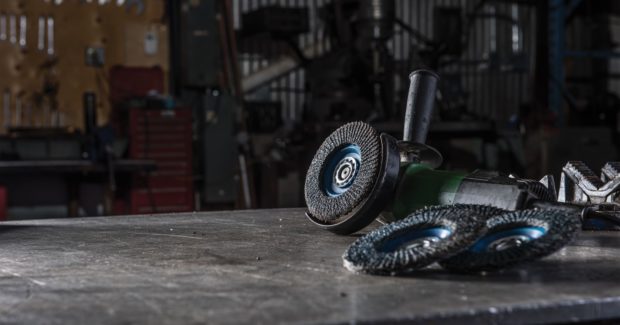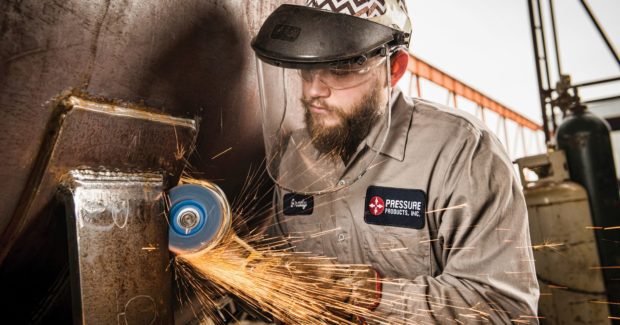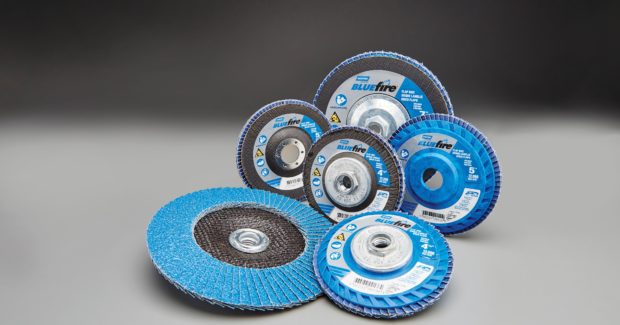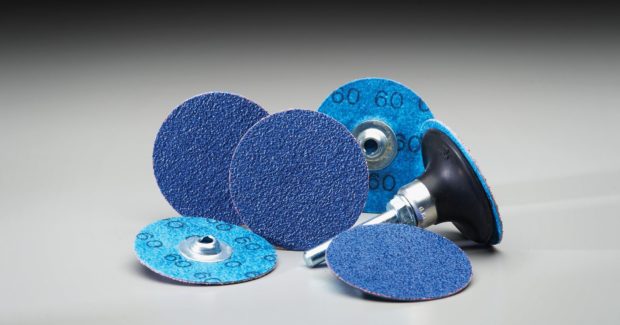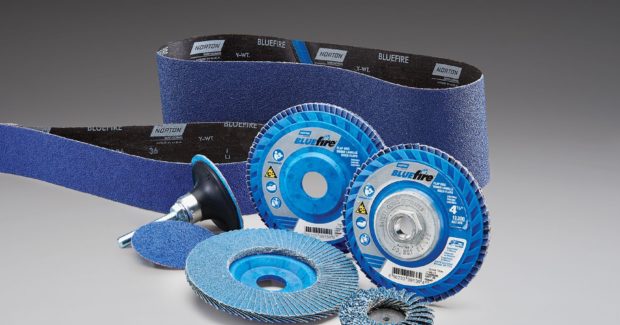Zirconia Abrasives – History, Applications and Latest Developments
Quality control in every step of the manufacturing process of abrasives products translates into advantages for customers.
Posted: February 22, 2022
SURFACE CONDITIONING
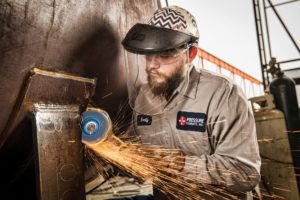
Metal fabricators have long benefitted from cutting-edge research and innovations regarding the product development of abrasives. Continued improvements in zirconia products, for example, include improvements in the grain as well as in the coated abrasive product design to optimize the grain. One abrasives company, Norton|Saint-Gobain Abrasives, has a long history of innovations in the product development of abrasives products. Recently, the company improved on the zirconia alumina abrasive grain and products with its “New Blue” series of products.
A Brief History of Zirconia Abrasives
The first Norton patent on fused alumina-zirconia was issued in 1917. This first zirconia abrasive had only 10% zirconia — a far cry and many generations of innovation away from today’s New Blue zirconia abrasive grain. The birth of the high-performance “blue” zirconia-alumina abrasive grain occurred in the 1970s with the first patent applied for in 1971 for the higher performance zirconia grain known as NorZon®.
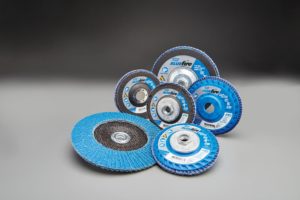
Before zirconia abrasives, the predominant grains were silicon carbide and fused aluminum oxide, which consisted of single crystals. However, the hardness and wear properties vary in a single crystal. In addition, single crystal fused alumina and silicon carbide grains tend to cleave in large chunks. Flaws or inclusions that are introduced during processing further weaken these grain types. Finer-grained zirconia abrasives have the strength and wear resistance to dig or cut into a surface, and then microfracture when stresses become too high in the abrasive.
In the 1970s and 1980s, Norton researchers invented several additional enhancements to zirconia abrasives leading to the release of second-generation zirconia coated abrasive products which were based on the NorZon®Plus abrasive grain. Several innovations in the adhesive bonding systems and backing were made to the abrasive product at this time. These improvements multiplied the benefits of the NorZonPlus abrasive grain, resulting in enhanced second-generation zirconia coated abrasive products which were introduced in the 1990s.
In 1990, Norton Co. was acquired by Saint-Gobain, a world leader in sustainable habitat. Saint-Gobain brought a long history and a high level of expertise in processing glass, refractories, furnace design and ceramic materials. Advances in the fusion or processing of zirconia abrasive grains were an outcome of the combined expertise. In the 2000s, third-generation zirconia coated abrasives were introduced based on the NorZon®Plus II abrasive grain.
Enter the Next Generation of Zirconia-Coated Abrasives

In 2021, Norton|Saint-Gobain Abrasives introduced the new BlueFire® zirconia coated abrasives based on a fourth-generation zirconia abrasive grain, which combines the latest innovations and optimization of grain shape, fusion processing and composition. The zirconia-alumina grain composition and shape are finely tuned to enhance resharpening and metal removal rates. While the original blue zirconia grain of the 1970s had a crystal size of 50 microns, the latest generation has a significantly smaller micron crystal size, which provides improved wear properties, superior toughness, and pronounced improvements in resharpening abilities due to controlled micro-fracturing.
The latest generation zirconia abrasive grain is a key performance factor; however, the enhancements provided by the BlueFire zirconia products extend beyond just grain improvements. Innovations in the coated abrasive product design fully optimize the benefits of the new zirconia grain.
Since the new abrasive stays sharper longer due to enhanced wear resistance and microfracture resharpening, physics dictates that this will put higher stresses on the adhesive bond and backings. For any applied normal force, the frictional or tangential forces on a disc or belt are higher when the product stays rougher or sharper. To completely utilize the new patented abrasive grain and deliver the best performance possible the abrasive is coupled with several additional proprietary improvements in backing, bond, and grinding aid systems to maximize cut-rate, material removal, life and performance.
The BlueFire zirconia products utilize a superior re-engineered polyester backing. In addition, the bond system has been improved with tougher, high-stability resins. Finally, an aggressive new grinding aid or supersize formulation is applied for certain applications. This further enhances material removal by reducing heating, sticking or capping, and loading when grinding reactive metals such as titanium, magnesium, aluminum, superalloys, high chromium tool steels and stainless steel.
The new 36-grit BlueFire R887D is a supersized zirconia product designed for grinding stainless steel, titanium, aluminum, superalloys, and magnesium, and provides 50% improvement in metal removal compared to the earlier generation zirconia product.
The R860 BlueFire product is the new non-supersized BlueFire zirconia product designed to optimize grinding performance on carbon steels, alloy steels, copper, brass, bronze, fiberglass and composites.
An upgraded resin bond and backing system reduces shedding and provides a more durable product even under high-pressure grinding applications. While highly effective at high pressures, the new BlueFire products also increase life and metal removal at low and intermediate pressures.
BlueFire R887D is available in belts and quick-change discs. BlueFire R860 is available in flap discs and quick-changes discs. BlueFire flap discs are available with a stiffer T29 conical fiberglass backing plate as well as a quick-trim T27 flat plastic backing plate.
Industries and Applications
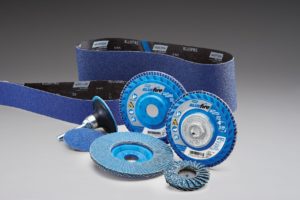
Sanding composite wind turbine blades are an excellent application for the BlueFire R860 products. Other key industries for the BlueFire R887D and R860 zirconia coated abrasives include aerospace, automotive, building and construction, plate and structural steel, welding and fabrication shops, and oil and gas.
Applications include:
- Beveling edges for weld preparation
- Blending parting lines on forgings and castings
- Flattening weld beads or excessive reinforcement
- Gate removal and blending on investment castings
- Heavy stock removal
- Deflashing molded parts
- Deburring holes and chamfering edges
- Surface refinement or finishing
BlueFire zirconia coated abrasives are suitable for grinding and finishing a wide variety of metal alloys including carbon steel, alloy steel, stainless steel, aluminum, titanium, magnesium, cobalt, reactive metals, refractory metals and nickel-based superalloys.
Consistent Quality
The long history of technical innovations in abrasive grain, fusion technology, and coated abrasive manufacturing are key factors in Norton’s leadership in the field of abrasive products, and vertically integrated manufacturing is another area of leadership. Norton controls quality in every step of the manufacturing process, from raw minerals fused into zirconia abrasives to making the coated abrasive material, to flexing and converting the elements into abrasive discs, belts, and other coated abrasive product forms. This translates into advantages for customers compared with using abrasive products that were created by converting jumbo rolls of coated abrasive material into discs, belts and other shapes. Because some companies do not manufacture the abrasive products themselves, they do not have the control of quality or understanding of the abrasive technologies (grain, backing, bonding, etc.) required to enhance abrasive life and material removal rate.
Even fewer coated and bonded abrasive manufacturers produce their own abrasive grains. Norton|Saint-Gobain is the only coated and bonded abrasive manufacturer who produces fused alumina-zirconia, ceramic, engineered abrasives, and silicon carbide, as well as a wide array of other abrasive grains. Quality manufacturing systems assure high productivity and long-lasting abrasives. What’s more, application engineers assist job shop personnel in optimizing the performance of their grinding and finishing operations.





